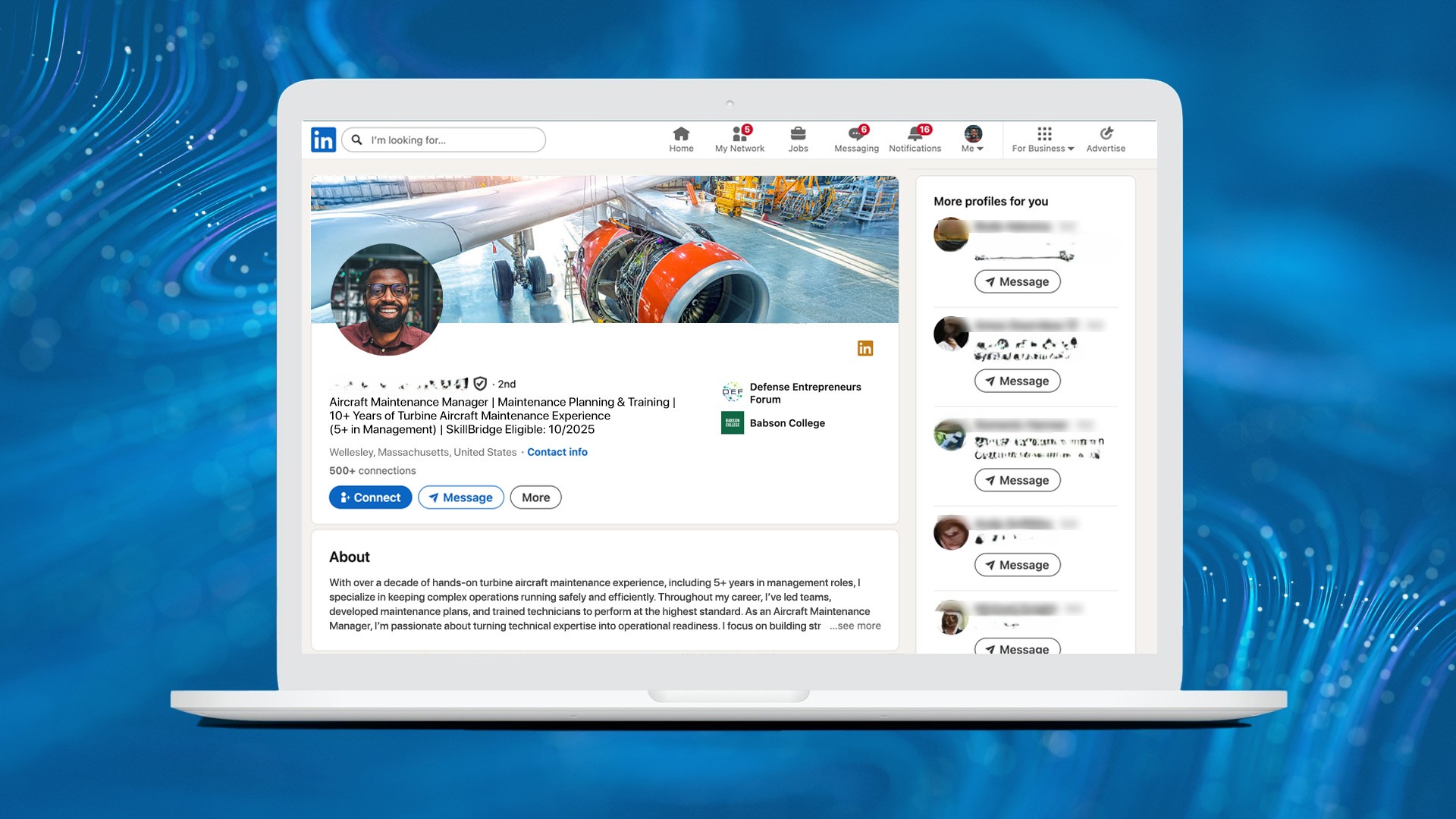LinkedIn Isn’t Optional: Tips for Service Members Entering Civilian Work
LinkedIn isn’t optional for service members entering civilian work. Learn how to build a strong profile, grow your network, and connect with employers.
By Justin Dal Colletto

When you transition from military service to civilian work, one of the first questions employers will ask themselves is, “Can I find this person online?” In today’s job market, LinkedIn isn’t optional. It’s expected.
A polished LinkedIn profile serves as your professional handshake. It shows you’re serious about entering the civilian workforce, helps recruiters understand your strengths, and positions you within the networks that lead to real opportunities.
Here are practical steps to make your LinkedIn profile work for you:
Start With a Strong Headline
Your headline is prime real estate. Instead of “Transitioning Service Member,” highlight your skills and target role. A good formula is [Title/field/Role] + [Industries/Skills] + [Value Statement]
For example:
Aircraft Maintenance Manager | Maintenance Planning & Training | 10+ Years of Turbine Aircraft Maintenance Experience (5+ in Management) | SkillBridge Eligible: 10/2025
This headline clarifies what you offer and the type of work you seek.
Tell Your Story in the About Section
The About section is your personal pitch. Use it to connect the dots between your military background and your civilian career goals. Keep it professional yet approachable, and steer clear of jargon. Aim for two or three short paragraphs that:
- Summarize your experience in plain language
- Highlight leadership, problem-solving, and technical skills
- State what industries or roles you are targeting
- “Brag Statements”: 2 to 3 professional achievements that you are most proud of
Translate your military experience into civilian impacts
There is a fine line of “translating” vs “lying”. For example, a Platoon Leader is not a CEO! Here is a better example:
- Platoon Leader (Team Manager – Operations, Training, & Personnel Oversight)
My advice, use your military title and translate in () next to it. From there, keep your bullets formatted using the CAR method (Context, Action, Result)
- Led a 35-soldier platoon (Context), developing and executing weekly training plans across 3 mission sets (Action), resulting in a 20% increase in evaluation scores and zero safety incidents (Result).
Showcase Your Skills and Credentials
Recruiters often filter LinkedIn searches by certifications, training, and education. Add any education or credentials that are recognized outside the military, from industry certifications to SkillBridge internships to degree programs.
Build Your Network & Ask for Informational Interviews
Do not wait until you need a job to start connecting. Follow companies you’re interested in, join professional groups, and engage with posts from industry leaders. Start sending connection requests to past colleagues you served with then move on to sending connection requests to hiring managers or SkillBridge POC’s. It’s important that you do not ask for anything in the initial connection, however, it’s fair game to express your interest in any open positions that align with your experience.
LinkedIn is also great to connect with veterans already in industry; especially those working in a career field you want to enter or may have done a SkillBridge you are interested in. This is personally one of my favorite techniques:
- Search LinkedIn for “SkillBridge Intern” and filter by your target companies of interest.
- Can’t find any? Remove the company filter and connect with interns at other companies.
- To find interns from your branch, filter by Previous Company = your branch (Army, Navy, etc.).
- When you find someone, send a connection request. After they accept, message them with a personalized note:
- Hi [Name], Great to connect! [Company Name] is on my radar for post-transition from the [Branch of Service] in [Year]. I see you are a current (or previous) intern at company. I’m still a bit far out from applying, but wanted to connect with some individuals such as yourself who have gone through the SkillBridge program at [Company Name]. Would you be open to sharing your experience so far with me over a 15 minute call? I'll pitch in for a virtual coffee! [Your Name]
Stay Active and Share Your Voice
An inactive LinkedIn profile is easy to overlook. Share articles, comment thoughtfully on posts, or write short updates about your own experiences. Regular engagement demonstrates your commitment to professional development and helps employers view you as more than just a resume.
Avoid Common Mistakes
- Leaving your profile incomplete or without a photo (Ideally a professional headshot in civilian attire!)
- Using jargon that recruiters outside the military won’t understand
- Copying your resume word-for-word into your profile
- Staying silent instead of engaging with your network
Final Thoughts
LinkedIn is not just another social platform. It is the front door to your civilian career. A strong, active profile helps employers find you, understand your value, and picture you in their organization.
The earlier you start building your presence, the better positioned you’ll be when the right opportunity comes along. Think of LinkedIn as your launchpad as it sets the stage for the career you want after service.
Recommended Resource
At Milivate, we know LinkedIn is one of the most important tools for your transition and we want to point you to trusted resources that can add extra value. One we recommend is Best Military Resume! Don’t be deceived by the name; not only does it help with building a tailored professional resume, it also has a free LinkedIn Profile optimizer!
Related Posts

From Intern to Full-Time Hire: Why SkillBridge Is a Win-Win

How to Set Up a SkillBridge Program at Your Company

